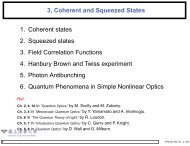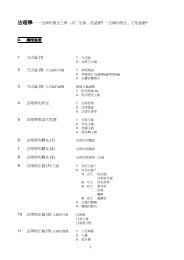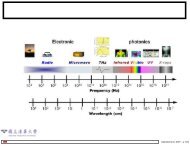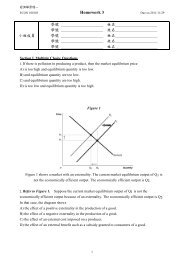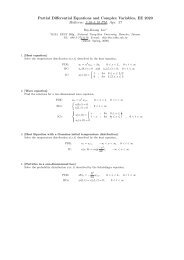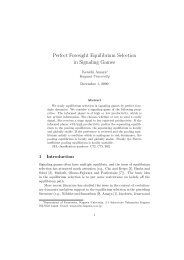Acceleration, Shock and Vibration Sensors
Acceleration, Shock and Vibration Sensors
Acceleration, Shock and Vibration Sensors
Create successful ePaper yourself
Turn your PDF publications into a flip-book with our unique Google optimized e-Paper software.
Chapter 5<br />
fier has been included. This is typically used to trim the sensitivity of the device so<br />
that it falls within a tighter tolerance. In this example, Point 7 shows how this amplifier<br />
can be used to gain the signal by a factor of two. Finally, there is a low pass filter,<br />
which is used to eliminate any high frequency ringing or residual affects of the carrier<br />
frequency.<br />
If silicon can be chemically machined <strong>and</strong> processed as the transduction element in<br />
a piezoresistive accelerometer, it should similarly be able to be machined <strong>and</strong> processed<br />
into the transduction element for a capacitive accelerometer. In fact, MEMS<br />
technology is applicable to capacitive accelerometers. Figure 5.2.15 illustrates a<br />
MEMS variable-capacitance element<br />
<strong>and</strong> its integration into an<br />
accelerometer. As with the previously<br />
described metal diaphragm<br />
accelerometer, the detection of<br />
acceleration requires both a pair of<br />
capacitive elements <strong>and</strong> a flexure.<br />
The sensing elements experience<br />
a change in capacitance attribut-<br />
able to minute deflections resulting<br />
from the inertial acceleration<br />
force. The single-crystal nature<br />
of the silicon, the elimination of<br />
Figure 5.2.15: MEMS capacitor plates <strong>and</strong><br />
completed accelerometer with top lid off.<br />
mechanical joints, <strong>and</strong> the ability to chemically machine mechanical stops, result in<br />
a transducer with a high over-range capability. As with the previous metal diaphragm<br />
accelerometer, damping characteristics can be enhanced over a broad temperature<br />
range if a gas is employed for the damping medium as opposed to silicone oil. A<br />
series of grooves, coupled with a series of holes in the central mass, squeeze gas<br />
through the structure as the mass displaces. The thermal viscosity change of a gas is<br />
small relative to that of silicone oil. Capacitive MEMS accelerometers currently operate<br />
to hundreds of g’s <strong>and</strong> frequencies to one kHz. The MEMS technology also results<br />
in accelerometer size reduction.<br />
Most capacitive accelerometers contain built-in electronics that inject a signal into the<br />
element, complete the bridge <strong>and</strong> condition the signal. For most capacitive sensors<br />
it is necessary to use only a st<strong>and</strong>ard voltage supply or battery to supply appropriate<br />
power to the accelerometer.<br />
148








